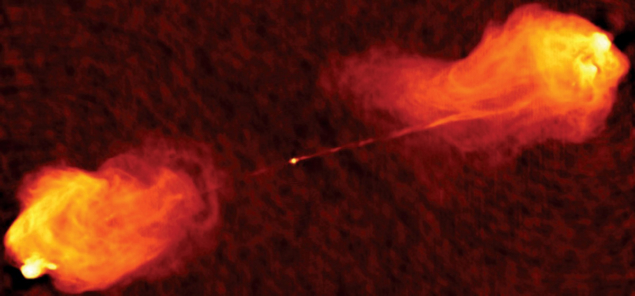
The ability to accelerate charged particles using the “wakefields” of plasma density waves offers the promise of high-energy particle accelerators that are more compact than those based on radio-frequency cavities. Proposed in 1979, the idea is to create a wave inside a plasma upon which electrons can “surf” and gain energy over short distances. Although highly complex, wakefield acceleration (WFA) driven by laser pulses or electron beams has been successfully used to accelerate electron beams to tens of GeV within distances of less than a metre, and the AWAKE experiment at CERN is attempting to achieve higher energy gains by using protons as drive beams. Recent studies suggest that WFA may also occur naturally, potentially offering an explanation for some of the highest energy cosmic rays ever observed.
So-called Fermi acceleration, first conceived by the eponymous Italian in 1949, is considered to be the main mechanism responsible for high-energy cosmic rays. In this process, charged particles are accelerated due to relativistic shockwaves occurring within jets emitted by black-hole binaries, active galactic nuclei or gamma-ray bursts, to name just a few sources. As a charged particle travels within the jet it gets accelerated each time it passes through the shock wave, allowing it to gain energy until the magnetic field in the environment can no longer contain it. This process predicts the observed power-law spectrum of cosmic rays quite well, at least up to energies of around 1019 eV. Beyond this energy, however, Fermi acceleration becomes less efficient as the particles start to lose energy due to collisions and/or synchrotron radiation. The existence of ultra-high-energy cosmic rays (UHECRs), which have been observed up to energies of 1021 eV, indicates that a different acceleration mechanism could be at play in that energy domain. Thanks to its very high efficiency, WFA could provide such a mechanism.
Although there are clearly no laser beams in astrophysical objects, plasma fields that can support waves can be found in many astrophysical settings. For example, in theories developed by Toshiki Tajima of the University of California at Irvine (UCI), one of the inventors of WFA technology, waves could be produced by instabilities in the accretion disks around compact objects such as black holes. These accretion disks can periodically transition from a highly magnetised to a little magnetised state, emitting electromagnetic waves that can propagate into the disk’s jets in the form of Alfven waves. As these waves continue to propagate along the jets they transform back into electromagnetic waves that can accelerate electrons on the front of the plasma’s “bow wake” and protons on the back of it.
Clear predictions
The energies that are theoretically achievable in cosmic-ray WFA depend on the mass of the compact object, as do the periodicities with which such waves can be produced. This allows clear predictions to be made for a range of different objects, which can be tested against observational data.
Groups based at UCI and at RIKEN in Japan recently tested these predictions on a range of astrophysical objects, spanning from 1 to 109 solar masses. Although not conclusive, these first comparisons between theory and observations indicate several interesting features that require further investigation. For example, WFA models predict periodic emission of both UHECRs – the protons on the back of the bow wake – in coincidence with electromagnetic radiation produced by the electrons from the front of the bow wake. Due to interactions with the intergalactic medium, UHECRs are also expected to produce secondary particles, including neutrinos. WFA could thereby also explain periodic outbursts of neutrinos in coincidence with gamma-rays from, for example, blazars, for which evidence was recently found by the IceCube experiment in collaboration with a range of electromagnetic instruments. Additionally, WFA could explain the non-uniformity of the UHECR sky such as that recently reported by the Pierre Auger Observatory (see CERN Courier December 2017 p15), as it allows for cosmic rays with energies up to 1024 eV to be produced within objects that lie within the location of the observed hot-spot.
In concert with future space-based UHECR detectors such as JEM-EUSO and POEMMA, further analysis of existing data should definitively answer the question of whether WFA does indeed occur in space. The clear predictions relating to periodicity, and the coincident emission of neutrinos, gamma-rays and other electromagnetic radiation, make it an ideal subject to study within the multi-messenger frameworks that are currently being set up.
Further reading
T Tajima et al. 2020 Rev. Mod. Plasma Phys. 4 7.
G Huxtable et al. 2020 arXiv.org:2009.12333.
T Ebisuzaki and T Tajima 2019 arXiv.org:1905.04506.







